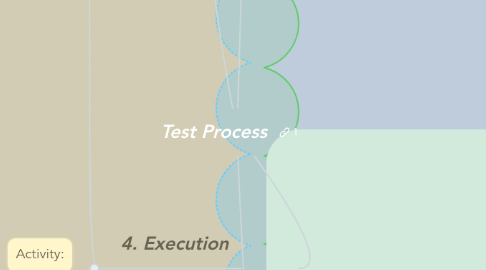
1. 4. Execution
1.1. Document
1.1.1. output
1.1.1.1. Test Item Transmittal Report
1.1.1.2. T. Log
1.1.2. input
1.1.2.1. T. Case Specification
1.2. Activity:
1.2.1. Relevant and Valid application requirements
1.2.2. Regression list?
1.2.3. If the defect lies with the software then complete details of the defect , should be passed to the development team for fixing, and again it should be re-tested
1.2.4. Testers should be aware of the possibility that the observed results could be due to an incorrect test
1.2.4.1. If its incorrect , it should be corrected and re-run
1.2.5. Changes in the test basis and the test object can render a test case incorrect even after the test has been run successfully many times
1.2.6. Reporting
1.2.7. Expected and actual results do not match
1.2.7.1. Ensure the test is right: refer back from the test data to the test conditions, documentation should be evaluated, refetence from the test data to the test conditionsto the source documentation.
1.2.7.2. Causes: Defects in the software, in the test data, in the test environment, in the requierment specifications
1.2.8. Comparing actual results with expected results - pass or fail
1.2.9. Execution of a corrected test to ensure that defects have not been introduced in unchanged areas
1.2.10. Re-execution of the test that previously faild in order to confirm a fix
1.2.11. Record the result of the test
1.2.12. Executing test cases manually or by tools
1.3. Definition
1.3.1. The process of running a test on the component or system under test, producing actual results
2. 1. Planning
2.1. Documents
2.1.1. output
2.1.1.1. T. Plan
2.1.2. input
2.1.2.1. T. Basis
2.2. Activity
2.2.1. Match the testing with the life cycle.
2.2.2. Prepare and review documents
2.2.3. resources and schedule
2.2.4. SUT
2.2.5. Test strategy
2.3. Definition:
2.3.1. The activity of establishing or updating a test plan.
3. 3. Implementation
3.1. Document
3.1.1. output
3.1.1.1. T.Case Specification
3.1.2. input
3.1.2.1. T. Design Specification
3.2. Activity:
3.2.1. Forming test execution schedule.
3.2.2. Creating and finalizing test data
3.2.3. Prioritizing test cases
3.2.4. Organazing test into execution order
3.2.5. Verifying the test environment
3.2.6. Creating test suites
3.2.7. Defining test cases
3.3. Definition:
3.3.1. The process of developing and prioritizing test procedures, creating test data and ,optionally, preparing test harnesses and writing automated test scripts.
4. 2. Analysis & Design
4.1. Doc. Analysis
4.1.1. output
4.1.1.1. T. Condition Matrix
4.1.2. input
4.1.2.1. T. Basis
4.1.2.2. T. Plan
4.2. Activity in analysis
4.2.1. Evaluating testability; Identifying the test objects and conditions
4.2.2. Design documents
4.2.3. Reviewing requirements, architecture, design documents
4.3. Doc. Design
4.3.1. output
4.3.1.1. T. Design Specification
4.3.2. input
4.3.2.1. T. Condition Matrix
4.3.2.2. T. Plan
4.3.2.3. T. Basis
4.4. Activity in design
4.4.1. Test data creation
4.4.2. Required infrastructure and tools
4.4.3. Test case design techniques;
4.4.4. Determine low-level or high-level test cases are most appropriate
4.4.5. design test based on the objects
4.5. Definition of Analysis&Design
4.5.1. General testing objectives are transformed into clear test conditions and test designs.The aplication should be analysed in detail from both a user's perspective, and rom a technical stand-point.
